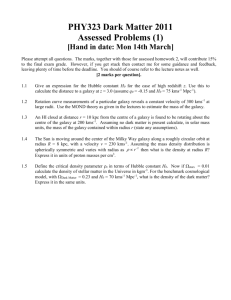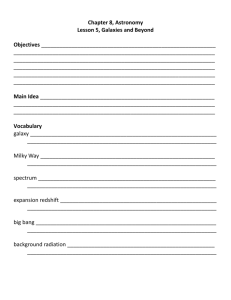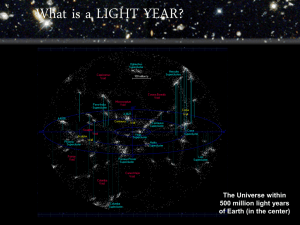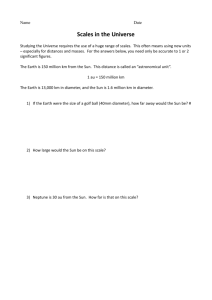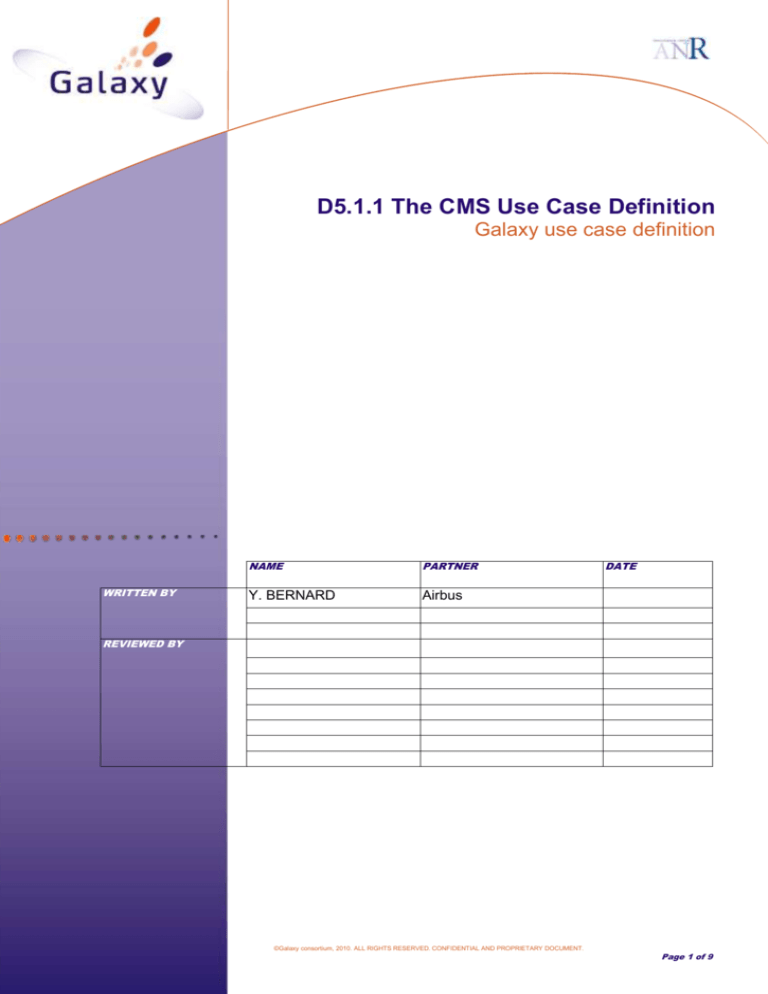
D5.1.1 The CMS Use Case Definition
Galaxy use case definition
WRITTEN BY
NAME
PARTNER
Y. BERNARD
Airbus
DATE
REVIEWED BY
©Galaxy consortium, 2010. ALL RIGHTS RESERVED. CONFIDENTIAL AND PROPRIETARY DOCUMENT.
Page 1 of 9
D5.1.1 The CMS Use Case Definition
PROJECT: GALAXY
REFERENCE: D5.1.1
ISSUE:
1.0 preDraft
Galaxy use case definition
RECORD OF REVISIONS
ISSUE
DATE
EFFECT ON
PAGE
01A
ARPEGE 2009
DATE:
05/09/2011
REASONS FOR REVISION
PARA
Document creation
©Galaxy consortium, 2010. ALL RIGHTS RESERVED. CONFIDENTIAL AND PROPRIETARY DOCUMENT.
Page 2 of 9
D5.1.1 The CMS Use Case Definition
PROJECT: GALAXY
REFERENCE: D5.1.1
ISSUE:
1.0 preDraft
Galaxy use case definition
ARPEGE 2009
DATE:
05/09/2011
TABLE OF CONTENTS
1. INTRODUCTION
5
1.1
GOAL OF THIS DOCUMENT
5
1.2
DOCUMENT ORGANIZATION
5
2. SCOPE
5
2.1
DESCRIPTION OF THE CMS SYSTEM
5
2.2
SCOPE OF THE STUDY
5
3. VALIDATION METHOD
6
4. INVOLVED PARTNERS
6
5. VALIDATION SCENARIOS
6
5.1
LOADING OF MODELS
6
5.2
VERSION MANAGEMENT
6
5.3
MODIFICATION IMPACT ANALYSIS
7
5.4
PUBLISH A MODIFICATION MADE ON A LOW LEVEL LAYER’S ELEMENT
7
5.5
TRACEABILITY BETWEEN SPECIFICATION AND CONCEPTION MODELS
8
5.6
BATCH ATL TRANSFORMATIONS (E.G. RSA-> PAPYRUS CONVERSION)
8
5.7
MODIFICATION MANAGEMENT PROCESS
8
6. INVOLVED MODELS
8
7. TOOLS USED
9
©Galaxy consortium, 2010. ALL RIGHTS RESERVED. CONFIDENTIAL AND PROPRIETARY DOCUMENT.
Page 3 of 9
D5.1.1 The CMS Use Case Definition
PROJECT: GALAXY
REFERENCE: D5.1.1
ISSUE:
1.0 preDraft
Galaxy use case definition
TABLE OF APPLICABLE DOCUMENTS
N°
TITLE
REFERENCE
ISSUE
DATE
ARPEGE 2009
DATE:
05/09/2011
SOURCE
SIGLUM
NAME
A1
A2
A3
A4
TABLE OF REFERENCED DOCUMENTS
N°
TITLE
REFERENCE
R1
R2
R3
R4
R5
R6
R7
Galaxy glossary
Goal and metrics document
Architecture specification
Galaxy glossary
D1.2.2
D1.1
D4.1
ISSUE
ACRONYMS AND DEFINITIONS
Except if explicitly stated otherwise the definition of all terms and acronyms provided in [R4] is applicable in
this document. If any, additional and/or specific definitions applicable only in this document are listed in the
two tables below.
Acronymes
ACRONYM
DESCRIPTION
CMS
Definitions
TERMS
DESCRIPTION
©Galaxy consortium, 2010. ALL RIGHTS RESERVED. CONFIDENTIAL AND PROPRIETARY DOCUMENT.
Page 4 of 9
D5.1.1 The CMS Use Case Definition
PROJECT: GALAXY
REFERENCE: D5.1.1
ISSUE:
1.0 preDraft
Galaxy use case definition
ARPEGE 2009
DATE:
05/09/2011
1. INTRODUCTION
The goal of the Galaxy project is to work on the technical hard points related to the fragmentation
and to the distributiveness of huge models, and to their synchronization in regards of the
communication means classically used by development teams. Galaxy partners believe that a set
of technical solution integrated in a common platform of service (called: “the Galaxy platform”) may
greatly help in dealing with these hard points.
Based on a selected subset of candidate technologies, the architecture of the platform has been
specified. As planned in the project proposal this platform is assessed using use cases where
scalability issues can be identified and characterized.
1.1
GOAL OF THIS DOCUMENT
A specific task of the Galaxy project (T5.1) is dedicated to the definition of the use cases. This
document is a product of this task which describes the CMS study case.
1.2
DOCUMENT ORGANIZATION
The chapter 2 describes the context of the test case, including an overview of the domain and a
focus on the scope on which of particular interest for the study.
Chapter 3 explains how the approach we have selected to verify and validate the added value of
the services provided by the Galaxy platform.
Chapter 4 presents the partners involved on this study case and the way they have contributed to
it.
Chapter 5 specifies the scenarios which are used to assess the performance offered by the Galaxy
platform.
Chapter 6 describes the models involved in validation scenarios are played: viewpoints, views,
sizes and organizations.
Last, Chapter 7 is about the tools software tools used for the validation scenarios.
2. SCOPE
2.1
DESCRIPTION OF THE CMS SYSTEM
Describe here the context of the domain of the study case and specific concepts of interest which
helps in getting a better understanding of it.
2.2
SCOPE OF THE STUDY
Focus here on the perimeter directly involved in the study case. Describe the scalability issues
which are used to assess the added value of the platform
Usage of the framework to support either time consuming and/or collaborative tasks the
development teams have to face during the development or the maintenance of a CMS system.
©Galaxy consortium, 2010. ALL RIGHTS RESERVED. CONFIDENTIAL AND PROPRIETARY DOCUMENT.
Page 5 of 9
D5.1.1 The CMS Use Case Definition
PROJECT: GALAXY
REFERENCE: D5.1.1
ISSUE:
1.0 preDraft
Galaxy use case definition
ARPEGE 2009
DATE:
05/09/2011
3. VALIDATION METHOD
Explain the approach and the process applied on this study case.
The validation is carried out in a two phases process. First, the validation scenarios are played on
the CMS with a “standard” TOPCASED v5.1 development platform, producing the reference data.
Then the Galaxy platform is used and the results are compared. Alternatively the reference data
could come from existing real cases, as long as they can be clearly characterized. Both objectives
and subjective performance data are assessed. Objectives data include measured execution time,
memory consumption and CPU usage. Subjective ones include users’ feedback.
The advantage of this approach is to allow an early start of the validation activities since the first
part, used to provide reference data does not require the Galaxy platform.
4. INVOLVED PARTNERS
All partner directly involved in this study case are listed here with their respective contribution.
Airbus (+ATOS), Akka
5. VALIDATION SCENARIOS
Describe the validation scenarios here:
Involved service of the Galaxy platform
procedure,
assessed metrics and corresponding objectives
5.1
LOADING OF MODELS
This scenario is directly related to the issues raised by the size of the models.
To be assessed:
Ability to open a model depending on its size
Time to load the model in a case of a regular and common use (i.e. day-to-day work)
Time to access randomly a given part of the model (restricted to realistic scenarios only)
Process with the initial framework:
Today we are able to load a subset but not the entire model (limit is the 32bits JVM). Model (whole)
file size in Papyrus format is around 170Mb. To be loaded more than 1.3Gb of RAM is required
(limit of the JVM 32).
Process with the Galaxy framework.
It is expected that the Galaxy framework prevent allow to deal with such big model without special
care on the user side.
5.2
TEAM WORK MANAGEMENT
This scenario addresses the issues directly related to several individual collaborating in parallel to
the definition of the same product and sharing the corresponding model.
To be assessed:
Capability of parallelized work on distinct parts of the model:
o modification of parts,
o workspaces update,
©Galaxy consortium, 2010. ALL RIGHTS RESERVED. CONFIDENTIAL AND PROPRIETARY DOCUMENT.
Page 6 of 9
D5.1.1 The CMS Use Case Definition
PROJECT: GALAXY
REFERENCE: D5.1.1
ISSUE:
1.0 preDraft
Galaxy use case definition
o
ARPEGE 2009
DATE:
05/09/2011
edition conflicts avoidance, etc…
Process with the initial framework:
The framework used during the development phase of the CMS system was based on a shared
directory which stored all the model files. Developers had no individual workspace and
synchronization between their works on the model was purely “manual”. Special care was required
to avoid overwriting between them.
The following scenarios have been created issues with the framework used during the
development phase:
…
Process with the Galaxy framework.
It is expected that the Galaxy framework prevent such issues to appear.
5.3
SPECIFICATION MODIFICATION: IMPACT ANALYSIS
This scenario deals with the way a modification of the upstream specification is managed. The
global model is modified by iteration. For each iteration, the whole model is modified and
exchanged between the Customer and the supplier.
To be assessed:
The ability to point out the modification made in the new version
The ability to detect impacted element downstream
The accuracy of the analysis
Process with the initial framework:
The impact analysis is a manual process based on human review of the textual requirements
linked to the model.
Process with the Galaxy framework.
Using the Galaxy framework, it is expected to be able to perform an automated impact analysis on
the whole model with minimal manual operations.
5.4
PUBLISH A MODIFICATION MADE ON A LOW LEVEL LAYER’S ELEMENT
This scenario is similar to the previous one except that in this case the modification is not made on
the upstream specification but on an integrated component (i.e. downstream). In case where parts
of models are reused between product or subparts, the shared model component will generally
have their own lifecycle.
To be assessed:
The ability to point out the modification made in the new version
The ability to detect impacted (“client”) element
The accuracy of the analysis
Process with the initial framework:
With the initial framework if a modification is made on the database component a manual impact
analysis is required on all the potential clients of this component.
Process with the Galaxy framework.
Using the Galaxy framework, it is expected:
©Galaxy consortium, 2010. ALL RIGHTS RESERVED. CONFIDENTIAL AND PROPRIETARY DOCUMENT.
Page 7 of 9
D5.1.1 The CMS Use Case Definition
PROJECT: GALAXY
REFERENCE: D5.1.1
ISSUE:
1.0 preDraft
Galaxy use case definition
5.5
ARPEGE 2009
DATE:
05/09/2011
to be able to perform an automated impact analysis on all the clients with minimal manual
operations.
To notify all team members working on these client component that a modified version is
available.
TRACEABILITY BETWEEN SPECIFICATION AND CONCEPTION MODELS
This scenario deals with the traceability analysis as required by the avionics development process.
To be assessed:
The ability to generate a downstream traceability analysis of the specifying elements
The ability to generate an upstream traceability analysis of the design
The ability to retrieve elements linked to design choices
Process with the initial framework:
The traceability analysis is performed on documents generated from the model which has been
manually annotated with all the traceability information.
Process with the Galaxy framework.
The traceability analysis is performed directly on the model and is able to use both the implicit
traceability information provided in the model “by construction” and the explicit traceability
information added manually by the developers in the model.
5.6
BATCH ATL TRANSFORMATIONS (E.G. RSA-> PAPYRUS CONVERSION)
The purpose of this scenario is to check in which extend the Galaxy framework can improve the
performance of batch model transformations. The test case is provided by the conversion from one
tool (Rational Rose) to another (MDT Papyrus) which are not based on the same technology and
then required a migration of the model file.
To be assessed:
Time and memory consumption required by the transformation versus models size.
5.7
MODIFICATION MANAGEMENT PROCESS
In the frame of an industrial development modification made on the product definition is realized
according to a controlled process, driven by a tool which has to be configured according to the
project specificities.
To be assessed:
Ability to generate a complete and correct configuration file from the model of the process.
Process with the initial framework:
The configuration file for the modification management tools is coded “by hand“.
Process with the Galaxy framework.
Assuming the modification process has been modeled, it is possible to generate this configuration
file.
6. INVOLVED MODELS
List and describe the kind of models (view, viewpoint) involved in the study case and the way they
are organized (relationships)
©Galaxy consortium, 2010. ALL RIGHTS RESERVED. CONFIDENTIAL AND PROPRIETARY DOCUMENT.
Page 8 of 9
D5.1.1 The CMS Use Case Definition
PROJECT: GALAXY
REFERENCE: D5.1.1
ISSUE:
1.0 preDraft
Galaxy use case definition
ARPEGE 2009
DATE:
05/09/2011
7. TOOLS USED
List the tools used in this study case with their corresponding version and purpose.
Topcased 5.1
o MDT Papyrus model editor (v0.81)
o GenDoc2 (vx.x)
o EMF compare
o Script
o OCL Rules Checker
o TOPCASED Req
o Tamore (vx.x)
ATL vxx
©Galaxy consortium, 2010. ALL RIGHTS RESERVED. CONFIDENTIAL AND PROPRIETARY DOCUMENT.
Page 9 of 9




